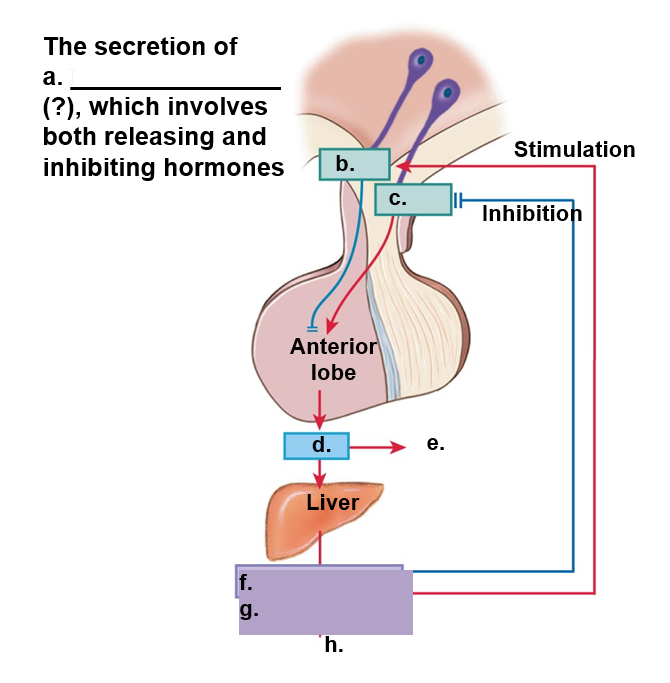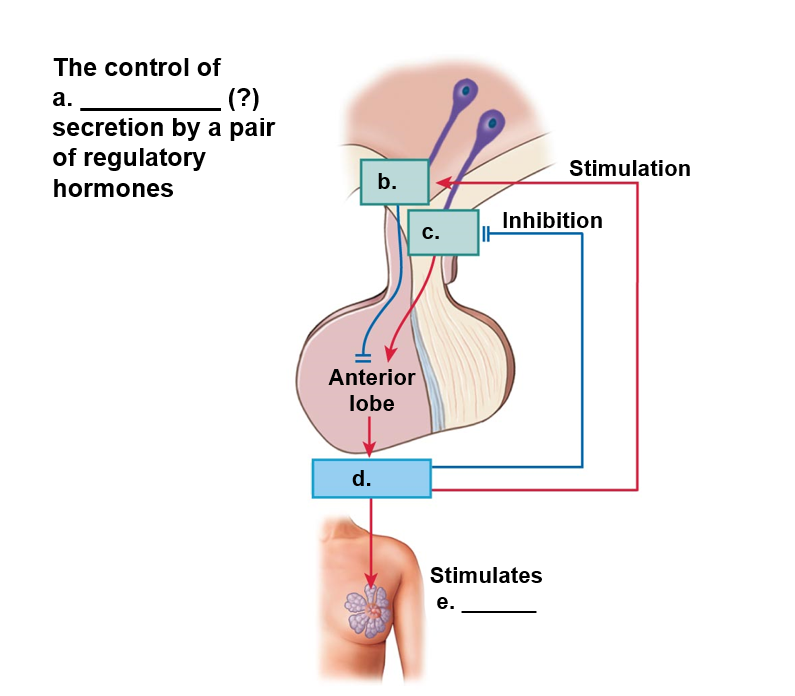Endocrine System P1
1/54
Earn XP
Description and Tags
missing slide 19, 22
Name | Mastery | Learn | Test | Matching | Spaced |
|---|
No study sessions yet.
55 Terms
Similarities between Endocrine and Nervous System
both use chemicals that bind to receptors on target cells;
share many chemical messengers (nervous = neurotransmitters; endocrine = hormones);
both managed mainly by negative feedback mechanisms;
both preserve homeostasis by directing/managing other cells, tissue, organs, and systems
What are the Mechanisms of Intercellular Communication?
direct, paracrine, endocrine, synaptic communication
Direct Communication:
Describe its transmission method, chemical mediators, and distribution effects
transmission: through gap junctions
chemical mediators: ions, small solutes, lipid-soluble materials
distribution effects: usually limited to adjacent cells of the same type that are interconnected by connexons
Paracrine Communication:
Describe its transmission method, chemical mediators, and distribution effects
transmission: through extracellular fluid
chemical mediators: paracrine factors
distribution effects: primarily limited to the local area, where paracrine factor concentrations are relatively high; target cells must have appropriate receptors
Endocrine Communication:
Describe its transmission method, chemical mediators, and distribution effects
transmission: through the bloodstream
chemical mediators: hormones
distribution effects: targets cells are primarily in other tissues and organs and must have appropriate receptors
Synaptic Communication:
Describe its transmission method, chemical mediators, and distribution effects
transmission: across synaptic clefts
chemical mediators: neurotransmitters
distribution effects: limited to very specific area; target cells must have appropriate receptors
What are the Hormone Chemical Groups (based on chemical structure?
amino acid derivatives, peptide hormones, lipid derivatives
What is the Significance of Amino Acid Derivatives? What do they include?
they’re one of three hormone chemical groups;
includes thyroid hormones, catecholamines (epinephrine, norepinephrine, and dopamine), and melatonin (from the pineal gland)
What is the Significance of Peptide Hormones? What do they include? How are they Synthesized?
they are a type of hormone chemical group;
includes most hormones of the body;
synthesized as inactive hormones (prohormones) that are then activated before or after release
What is the Significance of Lipid Derivatives? What do they include?
eicosanoids and steroid hormones
What are Eicosanoids? Describe why it’s important and show examples
a lipid derivative (hormone chemical group)
eicosanoids (carbon ring with fatty acid side chains):
important paracrine factors that coordinate cellular activities in extracellular fluids;
ex: leukotrienes (secondary role as hormones), prostaglandins (involved primarily in coordinating local cellular activities)
What are Steroid Hormones? Describe why it’s important and show examples
a lipid derivative (hormone chemical group)
steroid hormones (cholesterol based);
released by reproductive organs, adrenal cortex, cortex;
remain in circulation much longer since bound to plasma proteins
What Organs does the Endocrine System consist of?
organs whose primary function is hormone release;
many other organs secrete hormones but endocrine function is their secondary function (ex: heart, kidneys, intestines, thymus, and reproductive organs)
Pineal Gland Function
release melatonin, which influences reproductive function and helps establish circadian rhythms
Parathyroid Gland Function
releases a hormone crucial to the regulation of calcium ion concentrations in body fluids
Hypothalamus Function
secretes hormones involved with fluid balance and smooth muscle contraction;
also controls hormone secretion by the anterior pituitary gland
Pituitary Gland Function. What does it affect?
secretes hormones that regulates the endocrine activities of the adrenal cortex, thyroid gland, and reproductive organs;
also secretes a hormone that stimulates melanin production
Thyroid Gland Function
secretes hormones that affects metabolic rate and calcium levels in body fluids
Adrenal Glands Function
secretes hormones involved with mineral balance, metabolic control, and resistance to stress; the adrenal medullae release E and NE during sympathetic activation
Pancreas (Pancreatic Islets) Function
secretes hormones regulation the rate of glucose uptake and utilization by body tissues
Heart Endocrine Function
secretes hormones involved in the regulation of blood volume
Thymus Endocrine Function
secretes hormones involved in the stimulation and coordination of the immune response
Digestive Tract Endocrine Function
secrete numerous hormones involved in the coordination of system functions, glucose metabolism, and appetite
Kidneys Endocrine Function
secrete hormones that regulate erythrocyte production and the rates of calcium and phosphate absorption by the intestinal tract
Gonads Endocrine Function
secrete hormones affecting growth, metabolism, and sexual characteristics;
hormones also coordinate organ activity in the reproductive system
Define Endocrine System
network of glands and organs that produce and release hormones to regulate vital body functions.
For Cells to be sensitive to a Hormone…
a target cell must have the appropriate protein receptor, otherwise the circulating hormone has no effect
T/F: Cells have Receptors for many different Hormones.
Explain
true;
different combinations of receptors produce differential effects on specific tissues
Name the possible Receptor Locations on Target Cells
receptor in plasma membrane;
receptor in cytoplasm or nucleus
Describe the process of Hormone-Receptor Binding for a Receptor in the Plasma Membrane
involves water-soluble hormones that cannot cross plasma membrane
those hormones act as first messenger, relaying messages to an intracellular intermediary (second messenger);
secondary messenger (ex: cAMP and Ca2+) then affects cell’s enzyme activity and metabolic reactions;
generally involves a G protein (enzyme complex coupled to first receptor)
How does cAMP function as a secondary messenger after a Hormone (first messenger) interacts with a Receptor on the Plasma Membrane?
How are G proteins relevant to this situation?
many G proteins (associated with plasma membrane receptors) lowers/raises the concentration of cyclic-AMP (second messenger);
RAISED cAMP levels may activate enzymes or open ion channels, accelerating cell metabolism
DECREASED cAMP levels may reduce enzyme activity and have an inhibitory effect on the cell
How does Ca2+ act as a second messenger after a Hormone (first messenger) interacts with a Receptor on the Plasma Membrane?
Ca2+, along with calmodulin (intracellular protein), activates enzymes in cell
Describe the process Hormone-Receptor Binding for a Receptor in the Cytoplasm or Nucleus
lipid-soluble hormones (below) diffuse through plasma membrane:
steroids:
affects DNA transcription rate and protein synthesis;
changes synthesis of enzyme and structural proteins affecting cell’s metabolism and structure
thyroid hormones:
bind to receptors on mitochondria, affecting energy production;
bind to receptors in nucleus, affecting cell metabolism and structure
Describe the Events associated with the binding of a Steroid Hormone to Receptors in the Cytoplasm or Nucleus
diffuse through plasma membrane
binding of hormone to cytoplasmic or nuclear receptors
binding of hormone-receptor complex to DNA
gene activation
transcription and mRNA production
translation and protein synthesis
alteration of cellular structure or activity;
target cell response
Describe the Events associated with the binding of a Thyroid Hormone to Receptors in the Cytoplasm or Nucleus
diffusion across plasma membrane
binding of receptors to mitochondria and nucleus
leads to two scenarios:
increased ATP production → target cell response
OR
3. binding of hormone-receptor complex to DNA
4. gene activation
5. transcription and mRNA production
6. translation and protein synthesis
alteration of cellular structure or activity;
target cell reseponse
Name the Mechanisms that the Hypothalamus performs for Endocrine Function
has neurons that secrete two hormones released from the posterior pituitary (1. ADH // 2. oxytocin)
secretes regulatory hormones that control anterior pituitary gland endocrine cells
has autonomic (sympathetic) neurons that stimulate release of hormones from adrenal medulla
Describe how the Hypothalamus secretes Regulatory Hormones that control Anterior Pituitary Gland Endocrine Cells.
What are the Regular Hormone Types?
released from infundibulum;
transported to pituitary through fenestrated capillaries known as hypophyseal portal system (hypophysis, pituitary gland);
1. releasing hormones (stimulate hormone release)
2. inhibiting hormones (prevent hormone release)
Describe the Pituitary Gland.
Where is it and what Hormones does it release?
sits within sella turcica of sphenoid bone;
releases nine hormones:
seven from endocrine cells of the anterior pituitary (adenohypophysis): called tropic (trope, a turning) hormones because they “turn on” other endocrine glands;
two from hypothalamic axons in the posterior pituitary (neurohypophysis)
Name the Hormones released by the Anterior Pituitary (adenohypophysis)
thyroid-stimulating hormone (TSH), adrenocorticotropic hormone (ACTH), follicle-stimulating hormone (FSH), luteinizing hormone (LH), growth hormone (GH), prolactin (PRL), melanocyte-stimulating hormone (MSH), gonadotropins
Name the Hormones released by the Posterior Pituitary (neurohypophysis)
ADH, oxytocin (OXT)
What is Thyroid-Stimulating Hormone (TSH)?
Function? When does it get released, and when does its secretion decrease? Why release it? What releases it? What is its target tissue(s)?
stimulates release of thyroid hormones;
released in response to thyrotropin-releasing hormone (TRH) from hypothalamus;
decreased release when thyroid hormone levels rise (negative feedback);
target tissue: thyroid gland
What is Adrenocorticotropic Hormone (ACTH)?
Function? When does it get released? Why release it? What releases it? What is its target tissue(s)?
stimulates release of steroid hormones from adrenal cortex (specifically those that affect glucose metabolism);
released in response to corticotropin-releasing hormone (CRH) from hypothalamus
target tissue: adrenal cortex
What are Gonadotropins?
When does it get released? What releases it? Why release it?
released in response to gonadotropin-releasing hormone (GnRH) from hypothalamus
What is Follicle-Stimulating Hormone (FSH)?
Function? When does its secretion decrease? Why release it? What is its target tissue(s)?
females: stimulates ovarian follicle development and (in concert with LH) stimulates secretion of estrogens
males: stimulates sperm maturation
inhibited by inhibin (peptide released by gonads);
target tissues: follicles in the gonads
What is Luteinizing Hormone (LH)?
Function? Why release it? What is its target tissue(s)?
females: induces ovulation, stimulates secretion of estrogen and progestins (e.g., progesterone);
males: stimulates production of sex hormones (androgens), primarily testosterone;
target tissues: gonads
What is Growth Hormone (GH)?
Function? When does it get released? Why release it? What is its target tissue(s)?
What are the Disorders associated with it?
stimulates cell growth and reproduction by stimulating rate of protein synthesis;
released in response to growth hormone-releasing hormone (GH-RH) and growth hormone-inhibiting hormone (GH-IH)
target tissues: body;
disorders: pituitary dwarfism, gigantism, acromegaly
What is Prolactin (PRL)?
Function? When does it get released, and when does its secretion decrease? Why release it? What is its target tissue(s)?
works with other hormones to stimulate mammary gland development and milk production;
released in response to several prolactin-releasing factors;
inhibited by prolactin-inhibiting hormone (PIH);
target tissues: mammary glands
What is Melanocyte-stimulating Hormone (MSH)?
Function? Why release it? What is its target tissue(s)?
Do adults produce it?
stimulates melanocytes of skin to increase melanin production;
target tissue: melanocytes of skin;
in adults, almost none produced
What is ADH in the Endocrine System?
Function? When does it get released, and when does its secretion decrease? Why release it? What is its target tissue(s)?
also known as arginine vasopressin (AVP);
released in response to a variety of stimuli (primarily increased solute concentration of blood [sensed by osmoreceptors] or a decrease in blood pressure or volume);
inhibited by increase in extracellular fluid volume (also by alcohol);
primary function is to decrease water lost from kidney (also causes vasoconstriction);
vasoconstriction: collecting duct / DCT
What is Oxytocin (OXT)?
Function? When does it get released? Why release it? What is its target tissue(s)?
(OXT: okytokos, swift birth);
increased release in response to: child birth, nursing, sexual arousal (function unknown);
stimulates contraction of smooth muscle walls of uterus, mammary gland myoepithelial cells releasing milk
target tissues: mammary glands and uterus
Hormone Secretion is normally controlled through __________ feedback
Show an example
negative;
control axis of hypothalamus → pituitary gland → target endocrine organs provides many examples;
release of hormone from target endocrine gland suppresses: hypothalamic releasing hormone, pituitary hormone

Fill out the diagram.
a. growth hormone (GH)
b. growth hormone-inhibiting hormone (GH-IH)
c. growth hormone-releasing hormone (GH-RH)
d. growth hormone
e. epithelia, adipose tissue, liver
f. somatomedins
g. somatostatins
h. stimulates growth of skeletal muscle, cartilage, and many other tissues

Fill out the diagram
a. prolactin (PRL)
b. prolactin-inhibiting hormone (PIH)
c. prolactin-releasing factor (PRF)
d. prolactin
e. mammary glands
Name the Releasing Hormones of the Hypothalamus (and some of the inhibiting hormones that might accompany them)
Include what they cause the secretion of
growth hormone-releasing hormone or GHRH (somatostatin [SS] = inhibitory) → growth hormone (GH);
prolactin-releasing factor or PRF (prolactin-release inhibiting hormone [PIH]) = prolactin (PRL);
thyrotropin-releasing hormone (TRH) → thyroid-stimulating hormone (TSH);
corticotropin-releasing hormone (CRH) → arenocorticotropic hormone (ACTH);
gonadotropin-releasing hormone (GnRH) → luteinizing hormone (LH) OR follicle,stimulating hormone (FSH)